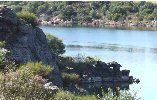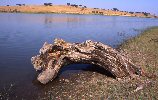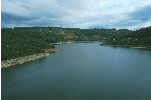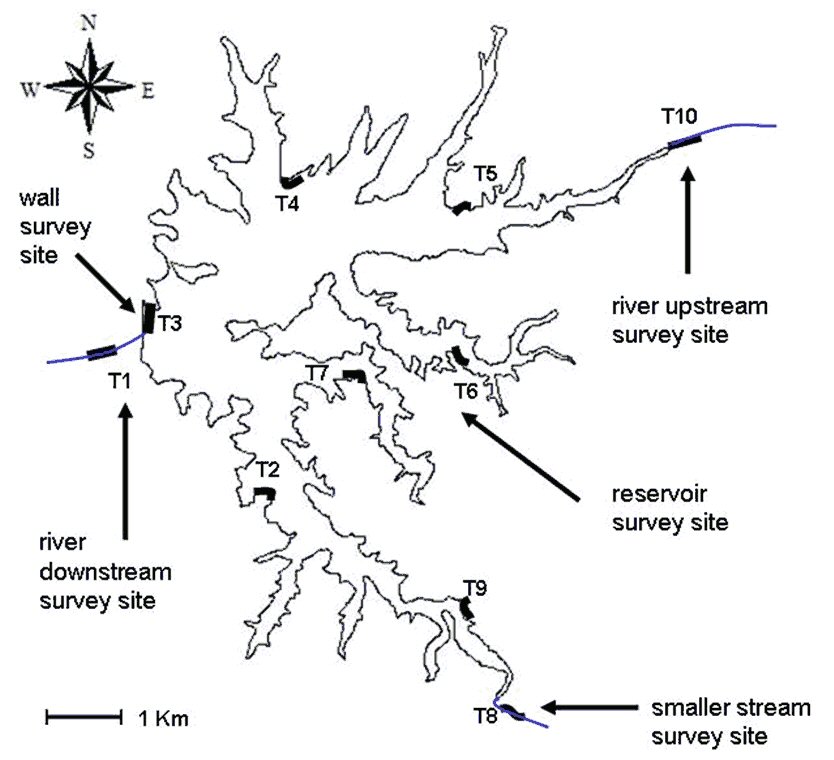 |
Last Update:
Thursday November 22, 2018
|
| [Home] |
INTRODUCTION One of the five species evaluation criteria in the IUCN Red List Categories and Criteria is the population trend (IUCN, 2001), and this requires observing changes in species distribution over time and space. For Eurasian otters (Lutra lutra) this translates mostly in presence/absence data resulting from spraint surveys. This occurs because otters are difficult to capture (particularly since the prohibition of use of leg-hold-traps – EEC 1991 - Council Regulation No 3254/91) and consequently to radio-track, and non-invasive molecular methods are still expensive and with a low rate of success due to the degraded condition of DNA from faecal samples. In the 80’s a survey method was developed for the Eurasian otter (Macdonald, 1983), and first adopted on a large scale during the national surveys of Britain and Ireland. This method uses surveys of stretches of 600 m of river banks for searching evidence of otter presence. Results are usually expressed in terms of percentage of positive sites, whether describing the data for a country, a region, a catchment, or some artificial unit such as a 10x10 km square (Chanin, 2003). This standard method for otter surveys was recognised as such by the IUCN Otter Specialist Group (OSG) after a major review of surveying methods carried out by Reuther et al., (2000). Most importantly the OSG standardised methodology enabled comparisons in presence/absence data in different countries whereas before it was difficult to assure that data were comparable (due to different surveys efforts, etc). This standard methodology for monitoring purposes in lotic systems (streams, rivers) may however, be complemented when applied to different types of systems, like lentic systems (large dams). This is especially relevant when we address otter presence and distribution in dry areas, such as the Mediterranean region, considered one of the biodiversity hotspots for conservation priorities (Myers et al., 2000), where different habitats or systems, such as dams, appear to have a role to play. Dams, and specifically large ones (defined as having a dam wall with ≥ 15 m of height, or a wall height between 5-15 m and a reservoir volume greater than three million m3 - WCD, 2000), are very different from the usual otter riverine habitats and we need to understand the influence of these “man-made” habitats on otter populations to be able to act on its protection. This context is especially relevant in Mediterranean areas or other similar regions, where water policy is largely based on such infrastructures, and streams suffer several other pressures (climatic and human). A reduction in dam building has occurred in North America and Europe in the last years, due to the facts that most of the technically appealing places for dam implementation having already been occupied, and there is now a greater concern for the environment. Nevertheless, dam building, especially large dams still continued in the last years in several countries (e.g. in Mediterranean countries like Portugal or Spain, or in developing Asian countries like India or China). As a consequence, case studies of otters and large dams appeared and, in the near future and with the uprising of environmental concerns, more studies are expected to occur, most of them linked with minimization and compensation environmental measures regarding dam implementation. The current scenario of climate change in Europe affects the riverine systems in the Mediterranean regions, mostly by extending the drought period. This is relevant, since increasing demand and management of water can influence otter distribution and affect long-term viability (Barbosa et al., 2003). Portugal, located in Western Mediterranean Europe, has always been one of the strongholds of otter in Europe, considered to be one of the most viable and widespread populations in Europe. Nation-wide surveys conducted in 1995 and 1998 at the coarse grid resolution of 10x10 km, as advised by the OSG, resulted in a broad otter presence across all of the country with the exception of the two main cities (Lisbon and Oporto). As a result, otters were downgraded in Portugal from “Insufficiently Known” to “Least Concern” (Cabral et al., 2005), a result that contrasts with its European status - “Near Threatened” category (IUCN, 2006). The objective of this paper is to propose adjustments to the OSG standard otter survey methodology, to focus on otter presence in dams, which can be applied specifically in the Mediterranean region or Mediterranean-type ecosystems, characterized by a highly marked seasonal climate with intermittent river flow. We will identify concerns of applying the OSG standard methodology to dam surveys and use the experience gained in studies conducted in Portugal to address these adjustments. OTTERS IN DAMS Few studies have addressed the use of dams by otters. Most of these complement the use of spraints with other methods, either because the authors were able to capture and radio-track otters (Somers and Nel, 2004), or because they could watch the individuals (Anoop and Hussain, 2004; 2005; Rosas et al., 2007). Somers and Nel (2004) caught seven Cape clawless otters Aonyx capensis in wire-cage traps in two rivers of South Africa and all included the Clanwilliam and Bulshoek dams in their home ranges. Anoop and Hussain (2004, 2005) in a study on smooth-coated otters Lutra perspicillata along the Periyar Dam (India) detected resting and foraging activities in that reservoir; they used both otter signs and direct observations of the species because smooth-coated otters are social carnivores that forage in groups and use communal sites for defecation (Hussain, 1996; Hussain and Choudhury, 1997). Rosas et al. (2007) collected data on the occurrence and habitat use of giant otters Pteronura brasiliensis in the Balbina hydroelectric lake in central Amazonia (Brazil), using motor boats to observe the otters. Regarding Eurasian otters, studies involving lentic systems are mostly on diet analysis on the basis of spraints (Gourvelou et al., 2000; Rhodes, 2004, Sales-Luís et al., 2007), and those that address habitat use mainly use snow-tracking (from early studies - e.g. Erlinge 1967, 1968; to other more recent: e.g Rimov reservoir, Czech Republic – Rhodes, 2004; central Finland lakes - Sulkava, 2006). Georgiev and Stoycheva (2006) in a study of otter in the Rhodopes Mountain (Bulgaria) that included two large dams, used both tracking in mud and wet soil and spraints. However, neither snow-tracking nor telemetry can be easily applied in Mediterranean countries, such as Portugal, since captures are difficult (particularly since the prohibition of use of leg-hold-traps – EEC 1991 - Council Regulation No 3254/91) and there are very few areas with snow due to the average high temperatures. Furthermore, studies relying on direct observations are difficult to implement. Research on the importance of lentic systems in the ecology of Eurasian otters in Portugal started in 1996 and is still ongoing. In this country, the authors showed that Eurasian otters use the reservoirs of large dams (Santos et al., 2007; Pedroso et al., 2007) and feed in them (Pedroso and Santos-Reis, 2006; Sales-Luis et al., 2007). Reservoirs seem to constitute an “attraction point” for otters particularly in drought periods when rivers and streams dry up (Prenda et al., 2001; Pedroso and Santos-Reis, 2006). Usually standard OSG method is applied to lotic systems, however there are obvious differences when we are dealing with large lentic systems (large reservoirs). From our studies we can point out several specific parameters of the lentic systems that can influence spraint detectability and otter marking behaviour, and should therefore be taken in consideration when surveying this type of habitats. 1 – Water level variation All of the reservoirs have fluctuation of the water level that result in a bank flooding area with scarce riparian vegetation. This fluctuation may be rapid and frequent, when we are dealing with dams used for electricity production, and water level may change very quickly over some meters in few days (e.g. dams of North and Center of Portugal, like the Aguieira Dam), or be slower, occurring over several weeks or months, as in dams used for irrigation or water consumption (e.g. dams of South of Portugal, like the 12 studied dams in the Sado and Guadiana basins). When reservoirs fill up to maximum or near maximum capability, the bank is flooded up to the vegetation line. This happens especially during wet seasons when the reservoirs fill up due to rainfall, and maintain the water level high, if possible up to the end of spring acting as a water reserve for irrigation and public consumption during summer and autumn. In the Aguieira Dam study (Pedroso et al., 2007), the water level was very high from March to July, sometimes submerging all the bank flooding area and thereby reducing spraint detectability. In this study, the decrease in numbers of signs in some of the months was associated with high water level in the reservoir. To avoid loss of information, particularly in the drier months when water was at its lower level, surveys in all of the 13 dams were extended to the entire bank flooding area, easily recognisable by the absence of vegetation due to water level variation. Signs found were distributed throughout the entire width of the bank flooding area, although around 80% were concentrated in the first five meters from the water edge. (Pedroso et al., 2007; Pedroso, unpublished data). Similar results were found by Anoop and Hussain (2004), in a study with smooth-coated otters (Lutra perspicillata) in the Periyar Lake Dam (Kerala, India), who found that if otters are present in an area their signs were most likely to be encountered within the 10 m perpendicular to the shoreline, and these authors used surveys of 250x10m along the water’s edge. 2 – Rainfall Rainfall influences spraints durability in the field. Otter surveys should not be carried out during periods when there is heavy rain since this may lead to a decline in the proportion of positive sites (Chanin, 2003). In reservoirs, bank flooding areas usually lack riparian vegetation and frequently have steep margins. These promote the washing out of spraints when subjected to rain. In the Aguieira Dam study, the decrease in number of signs between months (up to 260%) was associated with heavy rain, mainly from November to January (Pedroso et al., 2007). 3 – Presence of marking sites Most signs found in the studied reservoirs comprised spraints – 90.2%; 3.3% were prey remains, 3.0% were scent marks and 1.7% were footprints/tracks. The marking sites were consistent with those described for the species: isolated or small groups of rocks (55.0%), large rocky boulders (17.0%), soil surface (14.3%) and logs/branches/tree roots (8.0%); vegetation and small sand hills (<5.0% each) were also used (Figure 1).
Several papers state the use of these substrates as common marking places for otter (e.g. Georgiev 2007, in a study in South-East Bulgaria that included two small artificial lakes - 2,7ha and 4,7ha - refer that stones were the most marked substrate). Spraints at a specific marking site (e.g conspicuous rock) were a common feature of most surveyed sites. This site fidelity by Lutra lutra was already reported by several authors (e.g. Kruuk et al., 1986; Mason and Macdonald, 1986). Kruuk (2006) also states that spraints are left on prominent aspects of landscape (e.g. rocks, logs) that may be permanent spraint sites. This author reports that, in the Shetlands, the same sprainting sites are often used for many years. A similar observation was made by Anoop and Hussain (2004) in the Periyar Lake Dam where grooming and sprainting sites were regularly visited by smooth-coated otters. In our studied dams the number of spraints found was correlated with the number of marking sites (Pedroso et al., 2007; Basto et al., in prep.), which is a relation common in streams also (Sales-Luís et al., 2007). Relations between marking intensity and otter use in certain survey sites must take this in consideration. 4 - Bank side characteristics One aspect that may influence spraint detectability is bank steepness. Although no statistical significance was detected in the studied dams, generally banks with greater steepness had fewer signs than those less steep. Less steep stretches have a wider surface of bank flooding, corresponding to a larger potential marking area in months of low water level and, when flooded, a better chance of prey capture (e.g. Kruuk, 2006). To what extent otters use the deeper water in the studied reservoirs it is still unclear but it is likely that the otter is mainly using the shoreline of the reservoir, restricting its activity, especially foraging, to the littoral zones. This is supported by the fact that the main prey consumed in the reservoirs studied are present mainly around the shoreline (Sales-Luís et al., 2007) (Figure 2).
Other literature also addresses this aspect. Anoop and Hussain (2004) found that smooth-coated otters in the Periyar Lake Dam were confined to the shallower and narrower regions of the lake, where the bank was gradually sloping mud, avoiding deeper parts of the lake, with steeper rocky banks. The preferred areas for otters in the Periyar Lake were characterized by a slope of <5° and low water depth that extended over a few metres, and offered excellent foraging ground. Duplaix (1980) in Surinam made a similar observation, with giant otters Pteronura brasiliensis preferring low sloping banks with good cover and easy access to abundant prey. In the Shetlands, Kruuk (1995) also made similar observations for the eurasian otter. For example, otters foraged mainly in water usually less then 8 meters deep, with short dives. Georgiev and Stoycheva (2006) also did not found evidence of otter in the deep margins of two large reservoirs, and only in the areas close to the river inflow. Riparian vegetation, which plays an important role for otters in river tributaries (Macdonald and Mason, 1982; Bas et al., 1984; Lunnon and Reynolds, 1991), is expected to be also important in lentic systems. Kruuk and Goudswaard (1990), while investigating the reasons for the declining number of otters in Lake Victoria (Tanzania), described the virtual absence of otters from a section of the lake where the bank-side vegetation was poor. Anoop and Hussain (2004) made similar observations in Periyar Lake and suggest that vegetation cover on the bank may be important to otters throughout their distribution range. Results of the 12 dams in the South of Portugal confirm the importance of this resource, as vegetation availability was positively correlated with the number of spraints found. So it was expected that positive sites for otter presence would mostly be found in areas with good cover. However, in the Aguieira Dam, the number of otter signs was negatively correlated to cover (Pedroso et al., 2007). This, however, may have been a consequence of the fact that the reservoir of the dam was full for several months of the year, diminishing the bank flooding area; the flooding area available for survey was most of the times small or absent and the area next to it was difficult to survey since it was occupied by dense vegetation. Also, Kruuk (2006) stated that radio-tracked otters in Shetland did not show preference for particular vegetation and just happen to spraint near trees or shrubs. 5 – Survey length and width In the Aguieira Dam, 16 sites (six 600m and ten 200m transects) were surveyed monthly for one year (Pedroso et al., 2007). All 600m transects were visited by otters in the 12 months of the survey, with the exception of one where no otter signs were found on one survey. Similarly, all the shorter transects (200 m) were visited by otters and the visiting rate (number of occasions a given transect was found positive for otter presence over the total number of surveys of that transect) varied from 0.42 to 0.95, with 4 showing values above 0.75. In the other 12 dams, which were surveyed only once (during summer), a series of 200m transects were regularly spaced along the water edge (Pedroso and Santos-Reis, 2006). Whenever no otter signs were found, the transect was extended to 600m but this was necessary just in 16% of the occasions. This result suggests that 200m transects may be suitable for heavily marked dams (like the ones in dry regions during dry seasons). Although, Anoop and Hussain (2004) used 94 survey sites of 250m and only 69% were positive for otters, indicating that in less marked dams 200m might not be enough. 6 - Location of surveys As in streams, location of surveys in reservoirs is important for spraint detectability. When present in a reservoir, otters may not use the entire reservoir so we have to bear this in mind when choosing survey sites. In each of the 12 surveyed reservoirs in southern Portugal, a set of survey sites was implemented around the entire perimeter and 14.5% of these proved negative for otter presence (Pedroso and Santos-Reis, 2006). The criterion for selection of survey sites was that these should be approximately 5 kms apart. According to Erlinge (1967) most home ranges of Eurasian otter family groups that included lakes within their boundaries were found to extend over distances greater than 5 km, and those on rivers were larger. However, this data concerns the snow tracking method and a northern European country (Sweden). For Mediterranean streams, Saavedra (2002) found a mean of around 30 km of average total range and around 6km of core area, (Catalonian Region - Spain) and Jiménez et al. (1998) found home ranges of around 30km for males and 20 km for females (Castellón and Teruel - Spain). Therefore, the chance of a home range lying entirely between two survey points is low thus minimizing false negatives. Also, proximity to tributaries seems to be important, especially in reservoirs in the drier regions of southern Portugal. Here confluences of tributaries in reservoirs were heavily marked (Sales-Luís et al., 2007). The otters seemed to divide their time and movements between the dam, which provided nourishment, and the associated tributaries, which provided shelter (Sales-Luís et al., 2007; Pedroso et al., 2007; Pedroso, unpublished data). Georgiev (2009), in a study with eurasian otters in Southern Bulgaria, also addressed the question of where to place the monitoring zones, although this was in relation to small dams. In that study, the author stated that most of otter spraints were found in the areas close to the river inflow, followed by those near the wall of the dam. Anoop and Hussain (2004) also found that smooth-coated otters in the Periyar Lake Dam were usually found at the mouths of small streams that join the lake. The number of streams joining the lake, which influences the congregation of fish and the vegetation density, was interpreted to be the most important factor in determining habitat selection by otters around the Periyar Lake. One last aspect of survey location is the wall of the dam. All of the studied dam walls that allowed otter passage from and to the downstream tributary (small wall steepness, short distance from the wall to the downstream river) were marked in the surroundings, most of them on and around the wall itself and on small dirt pedestrian tracks leading from the wall to the reservoir and the tributary (Figure 3). Georgiev (2009) found that after the areas close to the river inflow, it was in the areas near the wall of the dam where most of otter spraints were found (although it must be repeated that this study took place in small dams).
7 – Human disturbance Human disturbance influences otter presence in several ways and may even limit otter populations (e.g. Beja, 1992; Robitaille and Laurence, 2002; Kruuk, 2006). That being so, one would expect marking behaviour and the corresponding amount of otter signs detected would also be influenced by human disturbance (i.e. fishing and aquatic sports). However, in the studied dams, no such relation was found. This may be because during most of the year disturbance in reservoirs is quite low, except during summer time when sporting and camping activities take place, or because there is a certain degree of adaptation to human presence and encounters are avoided with the usual secretive otter behaviour (nocturnal and discrete). This tolerance to human presence was also observed in the Periyar Lake, India (Anoop and Hussain, 2004; 2005). PROPOSAL FOR A METHODOLOGICAL APPROACH Portugal and other Mediterranean countries have a very distinct seasonality in water availability, with an almost complete absence of water from many streams in the dry season. The favourable status of otter populations in Portugal may lead otters to occupy, especially during dry seasons, habitats which are suboptimal in terms of refuge but offer profitable prey (Pedroso et al., 2004; Sales-Luís et al., 2007; Pedroso et al., 2007). Pressure for dam building and water management issues relating to it are more intense in drier regions, hence the necessity for studies on ecological communities and species protection, especially in Environmental Impact Assessments. The following methodological proposal, although clearly directed at dry regions, can also apply to regions with different characteristics and otter status. The suggested methodological approach to survey otter presence in dams is based on the standard survey methodology (OSG), which surveys 600m of riverbank for evidence of otter presence. Transects should be located along the bank of the reservoir (one bank instead of two as in streams). Further adjustments relate to: Surveying season Consideration of season is important in rivers with intermittent water regimes. As the effect of water level and rain can mask the influence of other variables in otter sprainting activity, it is important to survey in months that minimize these effects. In Mediterranean countries that may principally be in the summer and autumn. When performing single surveys these should not be implemented during the days after heavy rain or high water level (according to Chanin, 2003, there should be a period of at least five days without rain before surveying). Also, when dealing with sprainting, one should take into account seasonal variations in otter sprainting behaviour, which maybe up to tenfold between seasons (e.g. Kruuk, 2006). So, annual monitoring schemes should be conducted each year in the same season to diminish otter sprainting behavioural differences. Survey length and width Similarly to river surveys, 600 m transects are a reasonable compromise for otter regular monitoring, either only to detect otter presence/absence or for more in depth comparative studies. The survey should be concentrated in the first five metres from shore of the entire width of the bank flooding area. Nevertheless, for monitoring otter presence/absence in dams in dry regions, 200m transects are adequate as this minimises survey time and thus the number of sites to be surveyed per day. However, this survey length should only be used when more than one site is to be surveyed in the same reservoir. Alternatively, surveys may be planned to begin with 200m transects, moving up to a maximum of 600m transects in case no otter signs are found. Similarly to river surveys, this has the effect of avoiding false negatives. Number of survey sites To make it possible to say that otters are present in all of a reservoir, a series of regularly spaced survey sites, approximately 5 km apart, should be established. This degree of surveying in depth would give an insight into the otter’s specific habitat use, such as whether they are present at the point where tributaries run into the reservoir, or if they use the overall perimeter of the reservoir. Location of the survey sites When performing presence/absence surveys, and if proving otter presence in the entire reservoir is unimportant, the most crucial aspect is choosing the right sites for surveying. Suitable sites are usually selected by ease of access. Our data suggest that surveys located in the main inflow of the tributaries into the reservoir (Pedroso, unpublished data; Sales-Luís et al., 2007) are ideal places to survey. However, it must be considered that this is not necessarily representative of otter use in the totality of the reservoir perimeter, particularly when dealing with large reservoirs. To improve the probability of finding otter signs, surveys should be located on gently sloping banks, with many suitable potential marking places, near shallow water and beside or under any existing bridge. The dam wall itself can also be a good place to consider surveying, providing the wall is not steep and is a short distance from the downstream river, allowing otters to cross (Figure 4). Furthermore, if surveys are replicated seasonally, special attention must be given to traditional otter marking places in order to promote efficiency in detecting spraints.
Vegetation Survey sites with good vegetation cover above the bank flooding areas may reveal a high degree of marking behaviour and otter presence. However, the same sites during high water level may yield a very small surveying area due to the fact that the water reaches the dense vegetation (Pedroso et al, 2007). If surveys are to be repeated in time, looking for good marking substrates above the flooding area (if the vegetation allows it) is advisable before choosing survey sites. Type of dam The function of the dam is an important aspect, since it implies different water management policies. Hydroelectric dams have larger and faster shifts in water level, while agriculture/water reserve dams do not suffer sudden fluctuations. Water discharge downstream is also very different, and surveys in tributaries below hydroelectric dam may be compromised by the sudden water discharge that occurs for electricity production. Field surveys should therefore take place in the shortest time frame, in order to guarantee comparable conditions. The same applies to comparisons of presence/absence surveys in different years, such as in nation-wide surveys. CONCLUDING REMARKS The above suggestions may assist in a more efficient design of methodology
for assessing otter presence/absence, and they contain some adjustments
for applying standard survey methodology to large dams for Mediterranean
or Mediterranean-type ecosystems which are characterized by highly
marked seasonal climate with intermittent water flow. Generally Environmental
Impact Assessment Studies are limited by both budget and time, and
field researchers and biologists are forced to apply efficient and
cheap methodologies. Good distribution data on otters is a first step
to assess the effects of dam construction. The Eurasian otter is a
target species under the Habitat Directive, requiring regular monitoring.
Surveys in reservoirs, particularly when combined with surveys in associated
tributaries, will help to understand the impact of dam building on
otter populations. Further understanding of marking behaviour for making
inferences on habitat use and time spent by otters in these man-made
habitats must take into consideration not only that otters often use
certain areas without leaving any detectable signs, but that there
is also variation in the marking behaviour of otters of different age,
gender and reproductive status. Seasonality and prey availability may
also bring variation to marking behaviour and should be taken into
account. Radio-tracking data or molecular spraint analysis of otters
in dams would therefore complement these data, giving a better understanding
of how the otters use dams. This paper gives researchers some basic
guidelines in preparing dam surveys, to allow more effective surveys
to be conducted, whether surveying simply for otter presence, for regular
monitoring or for improving the collecting of fresh spraints for molecular
spraint analysis. AKNOWLEDGEMENTS: N. Pedroso was supported by a Ph.D. Grant (SFRH/BD/17495/2004) from the Fundação para a Ciência e a Tecnologia. Thanks are due to Hans Kruuk for suggestions on previous drafts and to Julian Mangas for the Spanish abstract. We also thank the two reviewers for their contributions to this manuscript. REFERENCES Anoop, K.R., Hussain, S.A. (2004). Factors affecting habitat selection by smooth-coated otters (Lutra perspicillata) in Kerala, India. J. Zool. 263: 417–423. Résumé : Evaluation D Ela Presence De La Loutre Sur Les Barrages: Proposition D'une Methodologie Resumen: Evaluación De La Presencia De La Nutria En Embalses: Una Propuesta Metodológica |
|||||||||||||||
| [Copyright © 2006 - 2050 IUCN/SSC OSG] | [Home] | [Contact Us] |






